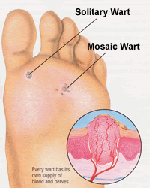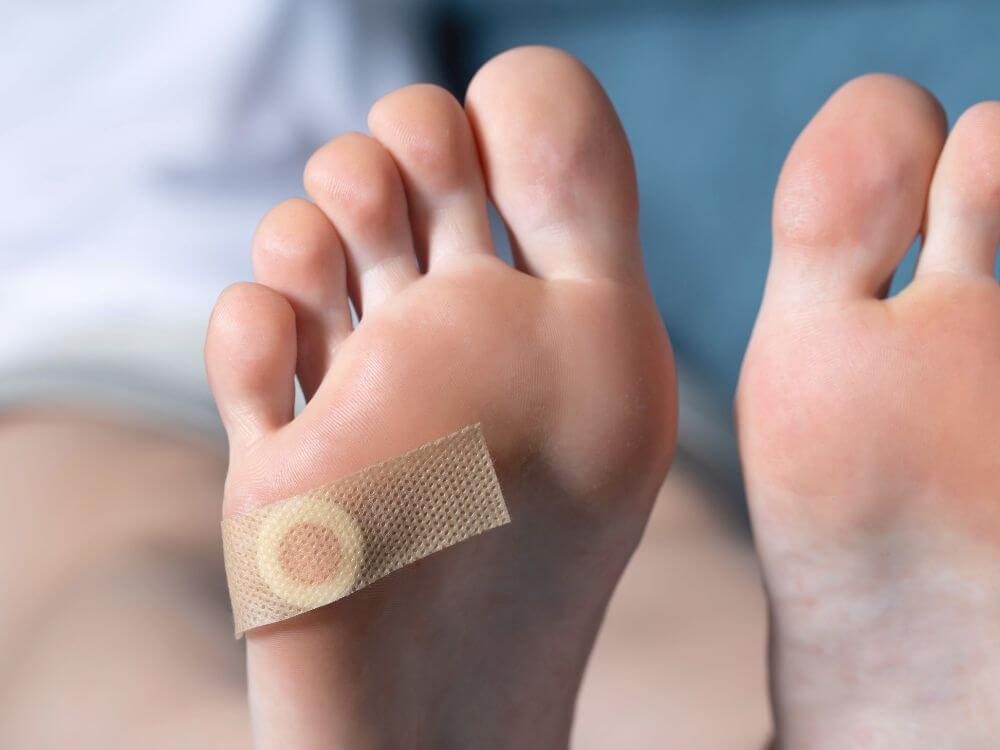Description of a plantar wart

Cause of a plantar wart
Warts are benign tumors that can occur anywhere on the skin. The human pappiloma virus (HPV), a common organism, causes warts, therefore it is contagious. The virus is often encountered on contaminated surfaces, typically the tile floors of public locker rooms, showers, swimming pools and doctor cabinets and invades the body through tiny cuts or breaks in the skin. Normally, antibodies in the blood kill the virus. Some people are more susceptible to the human pappiloma virus than others, however, and HPV takes refuge in the skin (not the blood).
A plantar wart is similar in structure to an iceberg. The part on the surface is a small fraction of the entire anomaly. Often, the portion of the wart under the skin is at least twice as big as the part you can see
Many of these viruses die within a year or two and the warts they produce simply disappear. Many podiatrists recommend having them removed because they are contagious, irritating and are often painful.
Treatment of a plantar wart
First of all, it must be said that none of these methods offers the guarantee of non-recurrence. Especially if the virus is in a latency period or in a sub-clinical state, i.e. if the viral particles or proteins are not visible to the naked eye. Professional care includes burning with acid, liquid nitrogen or conventional surgical or laser excision, and more recently, injection of “Bleomycin” into the lesion.
Bleomycin injection
First, let's look at the usual method in our clinic; injection of bleomycin. It is injected in a concentration ranging from 0.25 IU/ml to 1 IU/ml. Thus, intralesional injections are more convenient and more precise. We use a pressurized air syringe without a needle and we compensate for the normal loss of solution of 30-50% by injecting 1-2 ml at each wart per visit. The follow-up is done in the office 9 to 10 weeks later where the podiatrist examines the lesion and assesses the progress towards healing. The injection can sometimes be painful; patients may experience skin pinching, blistering or bruising. For some, it can last from a few days to a few weeks.
Anti-inflammatories (Motrin, Advil) or the application of ice can provide relief if needed. There are few general complications from using the "Bleomycin" solution other than some hives. Localized complications include Raynaud's syndrome, localized necrosis and nail dystrophy.
Thus, “Bleomycin” therapy is an excellent alternative for resistant plantar warts when administered by a trained practitioner. It is recommended in articles published in the journal of the American Academy of Dermatology (Guidelines of care for warts, JAAD 1995) and (Guidelines of care for nail disorders)
Surgical excision
First of all, you should know that the surgical excision of warts under local anesthesia offers a high rate of success and little recurrence. Postoperative discomfort comes from the deep cut to the dermis necessary for the operation. On the other hand, healing of the wound can take several weeks. Normal activity can usually resume after a few days depending on the size and number of warts that have been excised. The post-operative risks from this surgery are the possibility of infection and the formation of a scar which can be uncomfortable under the weight of the body while walking.
The principle of laser surgery is the burning of the lesion with the laser beam. The infected area must be desensitized by local anesthesia. This surgery is only advantageous for removing very many warts, very large warts or swarms. The risks of laser surgery are the same as for surgical excision, indeed the possibility of infection and a scar which can be embarrassing is possible.
Acids and non-prescription treatments
Over-the-counter medications are not very effective against plantar warts because they find it difficult to penetrate the thick skin under the foot.
Conventional treatments take longer to produce results. For plantar warts, cryotherapy (liquid nitrogen, Histofreeze) combined with salicylic acid gives good results in 50% of cases after 12 weeks of treatment. However, half of the other patients need to extend the treatment for an additional 12 weeks to obtain satisfactory results. This treatment for warts on the sole of the foot is painful and the wound takes several days or even weeks to heal.
Acids applied directly to the condition by the podiatrist as a single treatment are useful in the treatment of plantar warts. The advantage of this treatment is that it is practically painless unless the treatment requires a deep attack and the dermis has to be touched. In addition, there are almost no restrictions on normal activities. However, the water must not touch the treated point for a period of 24 hours. The disadvantage is that the treatment can be longer in duration as it requires weekly treatment.
Prescription drugs for topical or oral use may also be used in some cases.
Contact your podiatrist
Contact our podiatrist clinic in Laval, we will be delighted to meet you.
The information provided in this web site is not intended to be a substitute for medical examination, diagnosis or treatment. The material is provided for information purposes alone.

